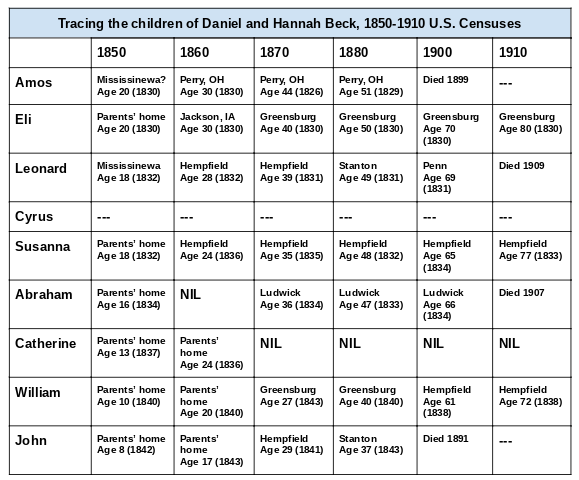
2020 is the Year of the Census. With extra time on our hands for genealogical research, have you considered completing a census study for an ancestral family?
I have been working on Generation 3 of my 4-generation project to submit for Level One in the ICAPGen accreditation process. This part of the project comes after spending hours and hours working on Generation 4, discovering the parents of Hannah Fisher and all of her siblings with original research, then disproving hypothesized parents for her father Jacob Fisher and discovering his actual parents. It is interesting that Generation 3 of the family – one that I thought was pretty well documented – has many holes and undocumented events on the FamilySearch family tree.
My research plan for this family began with trying to discover birth records for the children. I anticipated that I might find them in the indexed collection “Pennsylvania Births and Christenings” at FamilySearch. However, only one of their ten children appears in this index. He was baptized at Seanor’s/St.Paul’s church in Greensburg. There is a digitized copy of the church records for this church available and I think I might find at least some of the others in the original records, but it is a locked collection. With FamilySearch family history centers all closed due to the COVID-19 pandemic, I have no way of accessing those records right now, so I moved to the next part of my plan: census records.
I have spent the last few days locating every child of Daniel and Hannah Beck on every census from 1850-1910. It has been interesting to see the details of their lives unfold as I discovered their occupations, number of children born as well as number now living, and their residences at different times of their lives. Perhaps the most interesting part of this exercise has been noting the different ways their daughter Susanna Hantz’s name was spelled on each census. With all the different spellings and different guesses by indexers, it was difficult to trace Susanna. Luckily, she lived very close to her parents and some of her siblings throughout her life, so I was able to locate her by performing a page-by-page search of their hometown in Hempfield Township, Pennsylvania on each census.

This exercise has been telling. First, as genealogists, one thing we quickly realize is that ages reported on censuses can vary from year to year. This is clearly shown in the table below. The informant for census records prior to 1940 is unknown, and different informants might have been making their best guess about everyone’s ages.

I also discovered some inaccuracies and missing information on the FamilySearch family tree based on this study of the census. First, the birth order of the children was recorded erroneously on the family tree. Second, I was able to discover a previously unknown child of Susanna and David Hantz simply by sticking with my determination to locate them on every census. Their son lived at least to the age of 19, so it is amazing that he has not been located until now.
Another valuable result of my census study is that I was able to determine that Hannah and Daniel’s daughter Catharine likely died between 1860, when she was enumerated with her husband Michael Weaver in Daniel Beck’s household, and 1870, when her two likely children were in the Beck household without their parents. I now need to research additional records to verify their deaths or other circumstances that might explain why they weren’t with their children in 1870.
Clues Found in Census Records May Lead to Additional Records
There are a number of clues found in censuses that can lead to other records for individuals. These are detailed in an article by the National Archives. Here are just a few to get you started:
- Along with age and place of birth found on every census from 1850-1940, the 1900 census provides the person’s month and year of birth.
- The 1900 and 1910 censuses indicate the number of years of marriage for each married person.
- The 1900 and 1910 censuses indicate how many children were born to each woman and how many of those children were still living.
- The 1910-1930 censuses indicate the person’s year of immigration to the United States. This will help in locating a ship passenger arrival list.
- The 1900-1930 censuses indicate a person’s naturalization status, which may lead to naturalization records.
- The 1880-1930 censuses list parents’ birthplaces.
- Clues for military service can be found in the 1910 and 1930 censuses.
- Clues about land and property are found in each census from 1850-1930.
- Economic data and information about occupation found in the 1850-1880 censuses can lead to additional census non-population schedules that will provide additional information about ancestors.
Citing the Census
I have been keeping a research log as I work through this project, adding source citations for each census record as it is discovered. If you decide to complete a census study, here are my census citation templates that you are welcome to use as you record citations in your research log. Simply fill in all information enclosed by brackets.
1790-1840 Censuses:
(Template) [Year] U.S. census, [county] County, [state], [civil division], page [#] (penned), column [#], line [#], [name]; digital image, [Repository] ([URL] : accessed [date]); citing NARA microfilm publication MXXX, roll [#].
1850-1870 Censuses:
(Template) [Year] U.S. census, [county] County, [state], population schedule, [civil division], page [#] (stamped), dwelling [#], family [#], [name]; digital image, [Repository] ([URL] : accessed [date]); citing NARA microfilm publication MXXX, Roll [#].
1880-1940 Censuses:
(Template) [Year] U.S. census, [county] County, [state], population schedule, [civil divisions], enumeration district (ED) [#], page [#] (stamped), page [#] (penned), dwelling [#], family [#], [name]; digital image, [Repository] ([URL] : accessed [date]); citing NARA microfilm publication TXXX, roll [#].
If you are looking for a fun project that will help you get to know your ancestors better, discover clues that will lead to additional records, and possibly find additional family members, I would recommend a census study.
